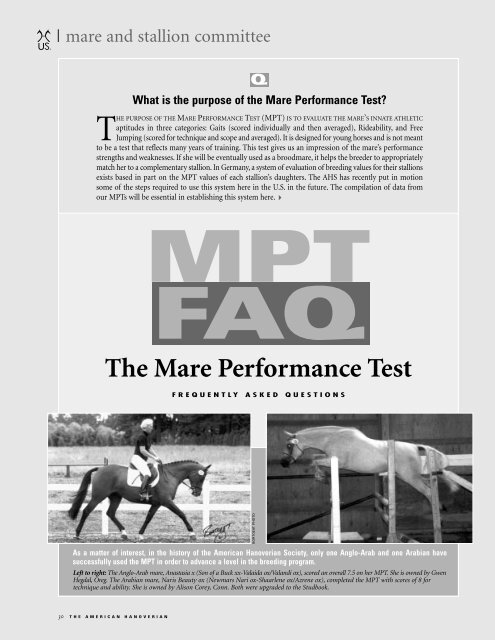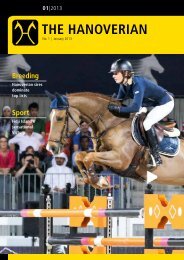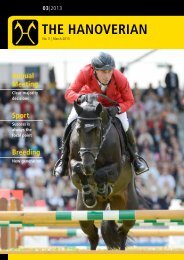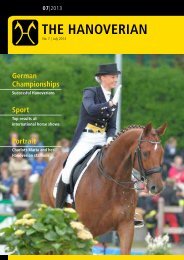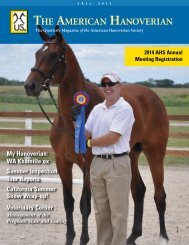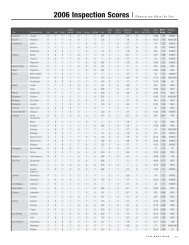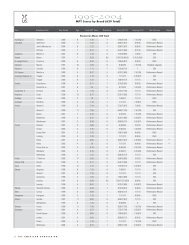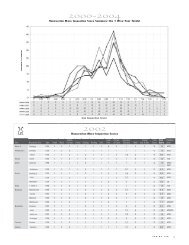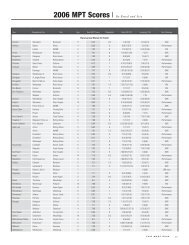MPT FACTS Article - the American Hanoverian Society!
MPT FACTS Article - the American Hanoverian Society!
MPT FACTS Article - the American Hanoverian Society!
Create successful ePaper yourself
Turn your PDF publications into a flip-book with our unique Google optimized e-Paper software.
mare and stallion committee<br />
Q<br />
What is <strong>the</strong> purpose of <strong>the</strong> Mare Performance Test?<br />
THE PURPOSE OF THE MARE PERFORMANCE TEST (<strong>MPT</strong>) IS TO EVALUATE THE MARE’S INNATE ATHLETIC<br />
aptitudes in three categories: Gaits (scored individually and <strong>the</strong>n averaged), Rideability, and Free<br />
Jumping (scored for technique and scope and averaged). It is designed for young horses and is not meant<br />
to be a test that reflects many years of training. This test gives us an impression of <strong>the</strong> mare’s performance<br />
strengths and weaknesses. If she will be eventually used as a broodmare, it helps <strong>the</strong> breeder to appropriately<br />
match her to a complementary stallion. In Germany, a system of evaluation of breeding values for <strong>the</strong>ir stallions<br />
exists based in part on <strong>the</strong> <strong>MPT</strong> values of each stallion’s daughters. The AHS has recently put in motion<br />
some of <strong>the</strong> steps required to use this system here in <strong>the</strong> U.S. in <strong>the</strong> future. The compilation of data from<br />
our <strong>MPT</strong>s will be essential in establishing this system here. <br />
<strong>MPT</strong><br />
FAQ<br />
The Mare Performance Test<br />
FREQUENTLY ASKED QUESTIONS<br />
BORTOEAT PHOTO<br />
As a matter of interest, in <strong>the</strong> history of <strong>the</strong> <strong>American</strong> <strong>Hanoverian</strong> <strong>Society</strong>, only one Anglo-Arab and one Arabian have<br />
successfully used <strong>the</strong> <strong>MPT</strong> in order to advance a level in <strong>the</strong> breeding program.<br />
Left to right: The Anglo-Arab mare, Anastasia x (Son of a Buck xx-Valaida ox/Valandi ox), scored an overall 7.5 on her <strong>MPT</strong>. She is owned by Gwen<br />
Hegdal, Oreg. The Arabian mare, Naris Beauty ox (Newmars Nari ox-Shaarlene ox/Azrene ox), completed <strong>the</strong> <strong>MPT</strong> with scores of 8 for<br />
technique and ability. She is owned by Alison Corey, Conn. Both were upgraded to <strong>the</strong> Studbook.<br />
30 THE AMERICAN HANOVERIAN
Q What is gained by doing <strong>the</strong> <strong>MPT</strong>?<br />
Every mare that takes <strong>the</strong> test will have her papers stamped to indicate<br />
that she has been performance tested. A permanent record will be<br />
on file in <strong>the</strong> AHS Central Office. If she is <strong>the</strong> daughter of a Main<br />
Studbook mare and is herself in <strong>the</strong> Main Studbook with an overall<br />
score of 7.0 or better, she can become an Elite Mare Candidate<br />
upon successful completion of <strong>the</strong> <strong>MPT</strong>. This means an overall<br />
score of 7.0 or higher (i.e. at least 21 points) or an 8 in one of <strong>the</strong><br />
three sections scored, with <strong>the</strong> o<strong>the</strong>r two sections scoring 6 (i.e. 20<br />
points). To complete <strong>the</strong> process and to obtain <strong>the</strong> title of Elite<br />
Mare, she must produce an AHS registered foal within three years.<br />
The Elite Mare title given in America is similar to <strong>the</strong> States<br />
Premium designation used in Germany.<br />
A Pre-Studbook Thoroughbred, Arab or Anglo-Arab mare can move<br />
up one level to <strong>the</strong> Studbook with <strong>the</strong> successful completion of <strong>the</strong><br />
<strong>MPT</strong> with a score of 7 (or an 8 and two 6s). They cannot, however,<br />
obtain Elite Mare status as <strong>the</strong> EM title is reserved for eligible<br />
<strong>Hanoverian</strong> Main Studbook mares only. As a matter of interest, in <strong>the</strong><br />
history of <strong>the</strong> <strong>American</strong> <strong>Hanoverian</strong> <strong>Society</strong>, only 34 Thoroughbred<br />
mares, one Arabian and one Anglo-Arab have successfully used <strong>the</strong><br />
<strong>MPT</strong> in order to advance a level in <strong>the</strong> breeding program.<br />
of <strong>the</strong> evaluation goes very much like a normal training session<br />
(please see “How do I begin to train my mare to free jump?” on page 33).<br />
If <strong>the</strong> mare likes this job, is clever and willing, <strong>the</strong>n she might be<br />
tested up to 4'-4'6"h by 3'-3'6"w. This would be <strong>the</strong> exceptional mare.<br />
There is no hard and fast rule as to how high <strong>the</strong> mare must jump, but<br />
<strong>the</strong> mare should be able to jump <strong>the</strong> larger oxer set at approximately<br />
3'6"h by 3'w. The judges will give <strong>the</strong>ir scores for technique and scope.<br />
If <strong>the</strong> mare is uninspected, <strong>the</strong>n you will be asked to present <strong>the</strong><br />
mare in-hand for conformation scores. You will be asked to walk<br />
her straight away from <strong>the</strong> judges and back for <strong>the</strong> correctness score.<br />
You might be asked to trot her in-hand if she only cantered in her<br />
free jumping warm up, or if <strong>the</strong> judges feel that she has a better trot<br />
than she showed at liberty. The mare will be asked to walk in a large<br />
circle in a group with <strong>the</strong> o<strong>the</strong>r mares being inspected at <strong>the</strong> site.<br />
The under saddle portion of <strong>the</strong> <strong>MPT</strong> is usually separated from <strong>the</strong><br />
free jumping by <strong>the</strong> inspection of <strong>the</strong> non-<strong>Hanoverian</strong> mares. This is<br />
to give both you and your mare a break. The mares will be evaluated<br />
in groups of two or three mares at a time. The test is run “manege”<br />
style, meaning that <strong>the</strong>re is a leader and <strong>the</strong> rest follow behind each<br />
o<strong>the</strong>r by three to four horse lengths. You should follow <strong>the</strong> person<br />
Q Which mares are eligible to take <strong>the</strong> <strong>MPT</strong>?<br />
Any mare registered with <strong>the</strong> AHS, and any non-<strong>Hanoverian</strong> mare<br />
that is entered into one of our studbooks can take <strong>the</strong> <strong>MPT</strong>. All<br />
Prior to free jumping, mares are allowed to loosen up and warm<br />
up in <strong>the</strong> arena. During this time, <strong>the</strong> judges will take note of her<br />
trot at liberty, as this, for most mares, will be her best trot.<br />
Right: Wrave (Wallstreet Kid-EM Georgey Girl/Garibaldi II) scored 8<br />
for technique and scope/ability and was high scoring mare of <strong>the</strong><br />
2002 Hilltop Farm test. Bred by Pat Limage, Va., and owned by<br />
Kathleen and Barb Poniatowski, Md.<br />
eligible mares are encouraged to do <strong>the</strong> <strong>MPT</strong>. The AHS encourages<br />
all owners and breeders to test <strong>the</strong>ir mares to determine strengths<br />
and weaknesses in order to fur<strong>the</strong>r evaluate <strong>the</strong> future performance<br />
use of <strong>the</strong> animal, <strong>the</strong> future breeding choices for <strong>the</strong> mare, and to<br />
begin a process of keeping statistical data on <strong>the</strong>ir sires.<br />
Q How does my mare benefit from <strong>the</strong><br />
designation of Elite Mare?<br />
Your mare benefits from <strong>the</strong> honor of being identified as one of <strong>the</strong><br />
best broodmares in <strong>the</strong> country. This is not a performance award,<br />
but ra<strong>the</strong>r a breeding award, and that is why <strong>the</strong> mares must prove<br />
that <strong>the</strong>y are reproductively sound by having an AHS registered foal<br />
within three years of becoming an Elite Mare Candidate. There is<br />
also <strong>the</strong> benefit of obtaining reduced stud fees from some stallion<br />
owners for Elite Mares.<br />
Q How will <strong>the</strong> test be run? What should I expect?<br />
The mares will be free jumped first. If your mare has not previously<br />
been inspected, she will be inspected during her free jumping time.<br />
She will be allowed to loosen up and warm up in <strong>the</strong> arena. During<br />
this time, <strong>the</strong> judges will take note of her trot at liberty, as this, for<br />
most mares, will be her best trot.<br />
You will be asked how much free jumping <strong>the</strong> mare has done and if<br />
she needs to have all <strong>the</strong> rails down to <strong>the</strong> ground to start. The rest<br />
in front of you, even if <strong>the</strong>y make a mistake. It is very important<br />
that this distance between <strong>the</strong> horses be kept <strong>the</strong> same during <strong>the</strong><br />
entire test, even if you have to cut across <strong>the</strong> arena or go deep into<br />
<strong>the</strong> corners. Certain exercises will have to be repeated if <strong>the</strong> mares<br />
spread too far apart.<br />
A sample test could be as follows: You’ll be asked to pick up a rising<br />
trot, complete a 20 meter circle at one end followed by a leng<strong>the</strong>ning<br />
down <strong>the</strong> long side, <strong>the</strong>n change across <strong>the</strong> diagonal and do <strong>the</strong><br />
same on <strong>the</strong> o<strong>the</strong>r rein. In a 20 meter circle you’ll be asked to prepare<br />
for canter and <strong>the</strong>n canter in <strong>the</strong> circle, <strong>the</strong>n go straight on with<br />
leng<strong>the</strong>ning down one long side, change leads through <strong>the</strong> trot<br />
across on <strong>the</strong> diagonal, and do <strong>the</strong> same on <strong>the</strong> o<strong>the</strong>r rein. When<br />
<strong>the</strong> judges have scores for trot and canter for each mare, you will be<br />
asked for a free walk on a long rein down <strong>the</strong> long sides, and perhaps<br />
across <strong>the</strong> arena. After this part, <strong>the</strong> judges should have scores for<br />
all three gaits. The short rideability part comes next. You’ll be asked<br />
to pick up a rising trot and ride a three loop serpentine <strong>the</strong> width<br />
of <strong>the</strong> arena, probably twice, <strong>the</strong>n develop canter at one end and<br />
canter across <strong>the</strong> diagonal with a change of lead through <strong>the</strong> trot at<br />
X and do <strong>the</strong> same on <strong>the</strong> o<strong>the</strong>r rein. You will <strong>the</strong>n walk and at <strong>the</strong><br />
end demonstrate a halt with immobility. This ‘test’ can change<br />
dramatically from site to site depending upon how well <strong>the</strong> group<br />
can stay toge<strong>the</strong>r, and if all <strong>the</strong> mares are behaving well. <br />
SPRING 2003 31
Mare Performance Test FAQ<br />
Q What should I wear? What saddlery is allowed?<br />
The proper attire for presenting <strong>the</strong> mare for free jumping and<br />
inspection is a conservative polo shirt and khaki pants with running<br />
shoes. For <strong>the</strong> under saddle portion, <strong>the</strong> rider should wear a white<br />
polo shirt or ratcatcher with conservative colored jacket (optional<br />
at 85 degrees and higher), light colored breeches and riding boots.<br />
Chaps and half chaps are discouraged. Saddlery must include a<br />
snaffle bridle for free jumping (minus <strong>the</strong> reins), for presentation<br />
and for <strong>the</strong> under saddle portion. The saddle must be of English<br />
style (no western, racing or steeplechase saddles). Protective boots<br />
and bandages are allowed for <strong>the</strong> free jumping portion only.<br />
In free jumping <strong>the</strong> mare will receive two scores, one for<br />
<strong>the</strong> technique and one for <strong>the</strong> scope or ability.<br />
Right: EM Pirouette (Pik Solo-Glueckskind/Gigant) scored an overall 7.5<br />
on her <strong>MPT</strong>, including an 8 for ability and 7 for technique for her jumping.<br />
Bred by Mary Jill Fisher, Calif., and owned by Caroline Hegarty, Calif.<br />
Q What do <strong>the</strong> scores mean?<br />
The <strong>MPT</strong> is scored in whole numbers only and <strong>the</strong> rounding up<br />
of scores is not permitted. A score of 4 is ‘insufficient’ and is<br />
rarely given; a 5 is ‘sufficient’ but is a low ‘passing’ score; a 6 is<br />
‘satisfactory’ and is an average score; a 7 is ‘fairly good’ and is an<br />
above average score; an 8 is ‘good’ and is a substantially above<br />
average score; a 9 is ‘very good’ and is nearly exceptional; a 10 is<br />
‘superior’ and is quite exceptional.<br />
In free jumping <strong>the</strong> mare will receive two scores, one for <strong>the</strong><br />
technique and one for scope or ability. The first score evaluates<br />
<strong>the</strong> mare’s ability to use (or control <strong>the</strong> individual parts of) her<br />
entire body to negotiate a jump. She must have some arch to her<br />
back, a bascule, be able to pick up her front and back legs so that<br />
<strong>the</strong> forearm is parallel to <strong>the</strong> ground and so that <strong>the</strong> hind legs do<br />
not trail behind and pull rails. Tucking <strong>the</strong> knees up into <strong>the</strong> chin and<br />
kicking up behind can only earn <strong>the</strong> mare more technique score.<br />
The next score is for scope. Scope assesses <strong>the</strong> ability to jump a big<br />
fence or to get to <strong>the</strong> bottom of a fence and show <strong>the</strong> power to<br />
jump up and over. The higher <strong>the</strong> score here, <strong>the</strong> more likely <strong>the</strong><br />
mare could be a jumper. These two scores are averaged to give one<br />
jumping score. Demonstration of <strong>the</strong> ability to jump a higher and<br />
wider fence is required for a score of 8 or higher in this category.<br />
In <strong>the</strong> under saddle portion of <strong>the</strong> test, <strong>the</strong> mare will receive a score<br />
for walk, trot and canter, and <strong>the</strong>se three scores will be added<br />
toge<strong>the</strong>r and divided by three for <strong>the</strong> gait score. She will also receive<br />
a separate score for rideability. This rideability score is a reflection<br />
of <strong>the</strong> mare’s willingness to accept <strong>the</strong> rider’s aids, her suppleness,<br />
her generosity, her ability to make <strong>the</strong> movements seem easy, and<br />
her natural balance, lightness and freedom. Just because <strong>the</strong> mare<br />
appears to be ‘on <strong>the</strong> bit’, or is more probably only flexed at <strong>the</strong><br />
poll, doesn’t mean that she is soft in <strong>the</strong> jaw and swinging through<br />
<strong>the</strong> back. A mare that scores high here is a mare that everyone<br />
would love to have <strong>the</strong> chance to ride, and conversely, <strong>the</strong> mare<br />
that scores low here, is <strong>the</strong> one people would prefer not to ride<br />
Q How do you construct a free jumping chute?<br />
Free jumping is best done in an indoor arena with mirrors<br />
covered. The chute should be set against a long wall. This long<br />
side wall of <strong>the</strong> arena must be imposing enough in height that<br />
<strong>the</strong> mare would never be tempted to jump over it. The side of <strong>the</strong><br />
chute near <strong>the</strong> center of <strong>the</strong> arena needs to be imposing enough<br />
(maybe 4') to discourage <strong>the</strong> mare from ‘escaping’. For <strong>the</strong> side of<br />
<strong>the</strong> chute, you can use one or two rails in between <strong>the</strong> standards<br />
and leave a small blank space on <strong>the</strong> landing side of each oxer so<br />
a person can slip in to adjust <strong>the</strong> height or to do fence repair.<br />
There are two types of jumping chutes: closed and open. The closed<br />
chute has an ‘end’ or ‘wall’ at one end so <strong>the</strong> mares must stop after<br />
<strong>the</strong> last jump. The open chute allows <strong>the</strong> mares to run out of <strong>the</strong><br />
chute. This gives <strong>the</strong> trainer <strong>the</strong> option of allowing her to return<br />
to <strong>the</strong> beginning of <strong>the</strong> chute by herself, or to be caught and led<br />
in. Letting her return to <strong>the</strong> beginning of <strong>the</strong> chute by herself allows<br />
her to keep going at a good canter stride after <strong>the</strong> larger oxer. It<br />
is very important that if you opt for a closed chute, <strong>the</strong> ‘end’ of<br />
<strong>the</strong> chute not be closer than 45 feet after <strong>the</strong> larger oxer, o<strong>the</strong>rwise<br />
<strong>the</strong> mares will possibly back off <strong>the</strong> last jump, break to a trot right<br />
after it or refuse to jump into what appears to <strong>the</strong>m to be a trap.<br />
It is best to err on <strong>the</strong> generous side and make <strong>the</strong> ‘end’ far<strong>the</strong>r<br />
than closer to <strong>the</strong> last jump. The closed chute must also have a<br />
‘gate’. This is to allow <strong>the</strong> mare a place to exit. It is usually just a<br />
single pole between two standards near <strong>the</strong> ‘end’. A bucket of<br />
grain available here can help catch <strong>the</strong> mares and avoid having<br />
<strong>the</strong>m use up too much energy in an effort to avoid being caught.<br />
The start of <strong>the</strong> open chute needs to be built a bit closer to <strong>the</strong><br />
short end, so <strong>the</strong> mare running free can use <strong>the</strong> short turn to collect<br />
herself before <strong>the</strong> first ‘X’. This open chute will not need as many<br />
materials as <strong>the</strong> closed chute, but of course both will need a side<br />
barrier to keep <strong>the</strong> mares inside <strong>the</strong> chute. For both, you will need<br />
lots of jump cups. Be sure to store any extra jump cups on top of <strong>the</strong><br />
arena kick wall or in a bucket, but not at <strong>the</strong> base of <strong>the</strong> standards.<br />
This is for obvious safety reasons. You will need materials for <strong>the</strong><br />
side chute, and three jumps, — one ‘X’, a small oxer and a larger<br />
oxer. You will need enough poles to construct <strong>the</strong> jumps and a<br />
few extra for breakage. Please use normal poles - no telephone poles.<br />
If your arena wall is slanted, you will need to add a triangular<br />
piece of cardboard or wood to <strong>the</strong> jump standards that are<br />
against <strong>the</strong> wall so <strong>the</strong> mare will not try to squeeze between <strong>the</strong><br />
standard and <strong>the</strong> wall. Special standards can also be constructed<br />
SHERI SCOTT PHOTO<br />
32 THE AMERICAN HANOVERIAN
to hang vertically from <strong>the</strong> kick wall. The first jump is just a simple ‘X’,<br />
followed by 22'6" (6.8m) to a small oxer, followed by 23'1" (7.0m) to<br />
a larger oxer. Be sure to use a ground rail at every jump. These distances<br />
are tried and true and <strong>the</strong>y work well for mares prepared<br />
well. Very inexperienced mares that hesitate and go too slowly or<br />
conversely, those that flatten out and go too quickly through <strong>the</strong><br />
chute, may find <strong>the</strong>se distances too long or too short.<br />
Q How do I begin to train my mare to free jump?<br />
Brushing boots and bell boots are allowed and you should use <strong>the</strong>m.<br />
It is best not to use polo wraps as <strong>the</strong>y can unwind during a round and<br />
become very dangerous.You will need a small bucket of feed as a reward<br />
after each round, a person to lead <strong>the</strong> mare in, who could also be <strong>the</strong><br />
same person that catches <strong>the</strong> mare. You will need at least two whip<br />
handlers using longe whips that have had lots of experience in jumping<br />
and have a good eye for jump take-off timing. It would also be nice<br />
if you had a lea<strong>the</strong>r lead strap made approximately two feet long to<br />
lead <strong>the</strong> mare into <strong>the</strong> chute and to catch her after each round.<br />
The first few times <strong>the</strong> mare goes through <strong>the</strong> chute, a whip handler<br />
should follow behind <strong>the</strong> mare to prevent her from turning around<br />
and running out <strong>the</strong> in-gate. One whip handler is stationed between<br />
jump one and two and <strong>the</strong> o<strong>the</strong>r between jump two and three. It is best<br />
not to hit <strong>the</strong> mare but to drop <strong>the</strong> lash down behind her so as to<br />
encourage her on through <strong>the</strong> chute. But forward progress is essential,<br />
and if she stops, she must realize that <strong>the</strong> only place to go is forward.<br />
You can start by leading <strong>the</strong> mare over three ‘piles’ of rails where <strong>the</strong><br />
jumps will be. Do this until she walks quietly over all <strong>the</strong> piles. Then<br />
walk her over <strong>the</strong> first pile, pick up a jog and <strong>the</strong>n <strong>the</strong> two of you<br />
jog over <strong>the</strong> next two piles. Do this until she is confident – for some,<br />
it’s one time and for o<strong>the</strong>rs, it’s many times. Next have your helpers with<br />
longe whips in place. Let her jog through on her own. Now you’re<br />
ready for some construction. The following is one suggestion: 1) two<br />
piles to an ‘X’; 2) one pile to two ‘X’s; 3) three ‘X’s; 4) two ‘X’s to a<br />
small vertical; 5) one ‘X’ to two small verticals. The mare will tell<br />
you when it’s enough for <strong>the</strong> first session. It is far better to go slow, and<br />
let her be confident and want to do <strong>the</strong> exercise again, than do too<br />
much,get her tired or overface her and have her lose confidence.<br />
In future training sessions, you advance from <strong>the</strong> ‘X’ and two small<br />
verticals to an ‘X’ to a small oxer (not square) to a larger oxer (also<br />
not square). Be sure to widen <strong>the</strong> oxer as you raise it and pull out<br />
CARLA CARLETON PHOTO<br />
<strong>the</strong> ground line some. The middle jump (<strong>the</strong> smaller oxer) usually<br />
stays at about 2'6" or 2'9"h by 2' or 2'3" w — this is a rounding<br />
fence, and for most mares, it helps set <strong>the</strong>m up for a good go at <strong>the</strong><br />
bigger oxer. The final oxer is <strong>the</strong> one that gets raised in height and<br />
width to <strong>the</strong> mare’s highest capability. If your mare gets quick and<br />
rushes <strong>the</strong> fences, she might need to be led into <strong>the</strong> chute at a walk.<br />
You can also put in ground poles halfway in between <strong>the</strong> jumps to<br />
make sure she puts in a canter stride and doesn’t try to bounce.<br />
These ground lines halfway in between <strong>the</strong> jumps, make <strong>the</strong> mare<br />
look, be careful, pay attention and slow up.<br />
I believe that a closed chute works better for most mares, because of<br />
<strong>the</strong> mares’ lack of training and conditioning. They do not have enough<br />
‘bottom’ to gallop around for five or ten minutes and play ‘catch me<br />
if you can’ in between each round. The closed chute saves time for<br />
all and saves <strong>the</strong> mare from running out of gas before she can progress<br />
enough each session. In <strong>the</strong> <strong>MPT</strong>, it could help her show what she<br />
can do before tiring out. This does not mean that an open chute is not<br />
acceptable or even better for some mares and some circumstances.<br />
The open chute can teach <strong>the</strong> mare to adjust her stride better.<br />
Every practice session at home need not test <strong>the</strong> mare to her highest<br />
capability. Ra<strong>the</strong>r, a slow steady build up of <strong>the</strong> height and spread of<br />
<strong>the</strong> jumps can instill confidence in <strong>the</strong> novice mare. If a bad schooling<br />
session happens, it is always best to go back down in difficulty until<br />
confidence is restored. Try to come to <strong>the</strong> test knowing <strong>the</strong> capabilities<br />
of your mare.<br />
Experience shows that <strong>the</strong> best-prepared mares usually are<br />
rewarded with <strong>the</strong> best scores for <strong>the</strong> day.<br />
Left: EM Wunder (Wer<strong>the</strong>rson-Deidre’s Decision/Dollberg) received a<br />
jumping ability score of 8. Bred by Cindy Wilkes, Ga., and owned by<br />
Jill Peterson, Fla.<br />
Q How often do I need to free jump?<br />
Free jumping can be great fun for everyone, especially <strong>the</strong> mare. It<br />
is disheartening to see ill-prepared mares make mistakes at <strong>the</strong> testing<br />
that should have been addressed at home. Free jumping should be<br />
done once a week for six to eight weeks before <strong>the</strong> testing. If <strong>the</strong><br />
mare is clever and has some jumping talent, <strong>the</strong>n she may catch on<br />
quickly and <strong>the</strong> extra sessions just build up more confidence. But<br />
for <strong>the</strong> mare that isn’t so clever or talented, she needs every single<br />
session she can get to do her personal best with confidence <strong>the</strong> day<br />
of <strong>the</strong> <strong>MPT</strong>. Experience shows that <strong>the</strong> best-prepared mares usually<br />
are rewarded with <strong>the</strong> best scores for <strong>the</strong> day.<br />
Hopefully this gives you some idea of what to expect at a <strong>MPT</strong>. The<br />
Mare and Stallion Committee members always remain available to<br />
help clarify and answer any questions you may have. If <strong>the</strong>re are<br />
inspections sites in your area, it is a good idea to go watch one<br />
before bringing your mare. Many of <strong>the</strong> inspection site hosts offer<br />
schooling sessions prior to <strong>the</strong> <strong>MPT</strong> day. Take advantage of clinics<br />
that may be offered. The judges and inspection site hosts want this<br />
to be a positive experience for both you and your mare. Have a<br />
happy and safe testing. Give it a try and good luck! ■<br />
AHS board member Suzanne Quarles was appointed to <strong>the</strong> AHS<br />
Mare and Stallion Committee in 1997. She judges extensively and<br />
has been a US Equestrian-licensed Combined Training judge and<br />
Technical Delegate since 1976.<br />
SPRING 2003 33


